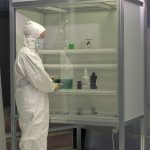 Water is one of the most widely-used ingredients in any cleaning solution. With the proper additives, water is an effective cleanser. However, in critical manufacturing, it is important to know that all water is different (even tap water in two different locations.) The quality of water directly impacts the quality of your product. Therefore, you need to choose the right kind of water for your cleaning application. Here is a breakdown of the different types of water.
Water is one of the most widely-used ingredients in any cleaning solution. With the proper additives, water is an effective cleanser. However, in critical manufacturing, it is important to know that all water is different (even tap water in two different locations.) The quality of water directly impacts the quality of your product. Therefore, you need to choose the right kind of water for your cleaning application. Here is a breakdown of the different types of water.
Tap Water: There are many instances when using tap water is safe. Know that water does absorb minerals from the ground and gases from the air, so there is no such thing as pure water. Tap water has an assortment of minerals in it depending on its location, and it also varies from season to season.
When you find water with higher levels of dissolved minerals (calcium, magnesium), the water is hard. If you have hard water at home, you know from looking at your dishes, sink, and tub that it leaves residue behind. This residue is difficult to clean. Additionally, hard water interferes with soap’s effectiveness.
If you have a water softener at home, you are also familiar with soft water. The water softening process relies on ion exchange. While it has lower concentrations of the hard minerals, the water now contains sodium. As for cleaning, sodium does not interfere as much with soaps, but the water itself has the same ionic content.
Deionized Water: That brings us to the removal of ionic properties. The ion exchange process to deionize water removes both cations (positively charged ions like calcium and sodium) and anions (negatively charged ions like chlorine.) As a result, the conductivity decreases – measuring this is how most deionized water is tested for effectiveness. Remember, though, the deionizing process does not remove non-ionic materials.
Reverse Osmosis: To understand the process, imagine that a semi-permeable membrane separates one side of “pure” water with another side that contains dissolved material. Normally, water would pass back and forth until the concentration on both sides of the membrane is equal. In reverse osmosis, rather than creating an isotonic concentration of water, pressure is used to reverse the process. The dissolved material side is forced to move to the purer side. This filtration process does separate most dissolved material, but not all.
Distilled Water: Most ionic and inorganic properties have a lower vapor pressure than water. As such, evaporating those materials into a separate container effectively removes them. However, organic solvents that have a substantial vapor pressure will still be in the distillate.
Distillation and reverse osmosis are most commonly used to produce Water for Injection (WFI). This WFI meets USP specifications that limit organic, inorganic, and biological impurities.
UV light is also sometimes used to kill bacteria, but the dead bacteria is not separated from the water.
It is easy to compromise the purity of any water, so choosing the right one will depend on your needs. You have to decide whether cleaning your facility is a question of ionic materials, dissolved materials, organic materials, and anything else that is left behind in any type of water you may use
Gerbig Cleanrooms manufactures AireCell Cleanrooms. For questions about cleanroom processes or requirements, contact us at 888-628-0056 or info@gerbig.com.
* Information obtained from the Controlled Environments article “Perfect Water,” by Barbara Kanegsberg and Ed Kanegsberg,